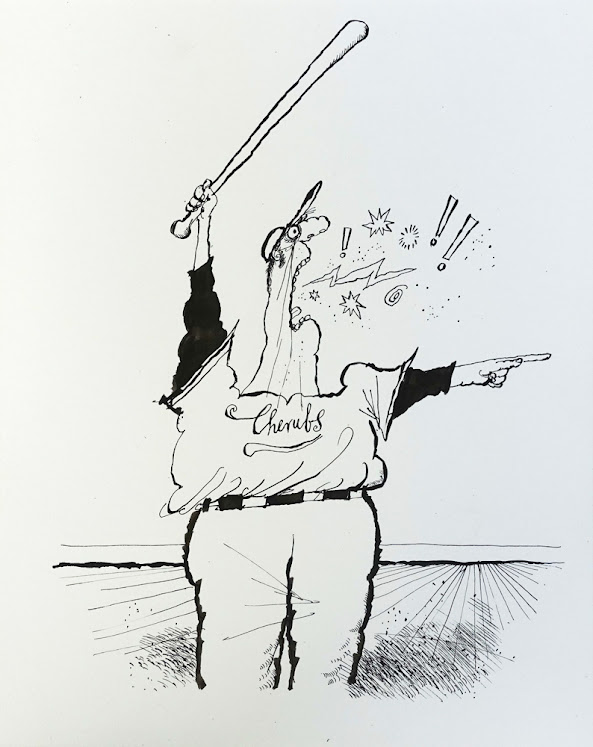The son of a railwayman, Ronald Searle was born in Cambridge on 3 March 1920, and educated in the town at the Boys' Central School. He started work as a solicitor's clerk, and then joined the hire purchase department of the co-operative Society, studying in the evenings and later full-time at the Cambridge Daily News from the age of fifteen.
This resulted in his first cartoon for Lilliput, published in October 1941, and later developed into one of his most famous creations, through a series of books and their cinematic spin-offs. Remarkably, he survived the horrific experiences of the Changi Camp, Singapore as a Japanese prisoner-of-war and managed to produce a visual record of life in a prison camp.
On his return to England in 1945, he exhibited the surviving pictures at the Cambridge School of Art, and published Forty Drawings. The exhibition and volume together established his reputation as one of Britain's most powerful draughtsmen, and led to several opportunities to record the atmosphere of post-war Europe. He contributed to Punch and these drawings crystallised in, The Female Approach (1949). Throughout the fifties, he produced a large variety of illustrations, which together seemed present a guide to life in Britain in the 1950's.
Such was his success that his rejection of family and country in a move to Paris in 1961 came as a great surprise. However, it offered a fresh start, resulting in several solo shows, including a major exhibitions at the Bibliotheque Nationale, Paris, the Berlin-Dahlem Museum and the Wilhelm-Busch-Museum, Hanover. He also reached a new audience with his contributions to film and television, most notably The Magnificent Men in their Flying Machines (1965).
Note: Searle did too many works to post in one series, so I am posting them in two separate series: 1940-1960, and 1961-2007.
For a more detailed biography see part 1, and for earlier works, see parts 1 - 13 (series 1) & parts 14-23 (series 2)
This is part 24 of a 26-part series on the works of Ronald Searle:
1988 Ronald Searle's Non-Sexist Dictionary - published by Ten Speed Press, Berkeley:
 |
 |
 |
 |
 |
 |
 |
 |
 |
 |
| Simply Confused |
 |
 |
 |
| 1991 In the Bleachers 36.6 x 26 cm Wilhelm Busch – Deutsches Museum für Karikatur und Zeichenkunst © The Ronald Searle Cultural Trust |
 |
| 1991 Steal! 36.1 x 25.7 cm Wilhelm Busch – Deutsches Museum für Karikatur und Zeichenkunst © The Ronald Searle Cultural Trust |
 |
| n.d. To the Victor Goes the Cork |
 |
| 1987 The New Yorker 2 February |
 |
| 1987 Opinion - International Herald Tribune 5 October |
 |
| 1988 Le Comble Wilhelm Busch – Deutsches Museum für Karikatur und Zeichenkunst © The Ronald Searle Cultural Trust |
 |
| 1988 Julius Caeser in Egitto 38.9 x 37 cm Wilhelm Busch – Deutsches Museum für Karikatur und Zeichenkunst © The Ronald Searle Cultural Trust |
 |
| 1988 For the Bicentenaire de la Revolution Française Wilhelm Busch – Deutsches Museum für Karikatur und Zeichenkunst © The Ronald Searle Cultural Trust |
 |
| 1988 Bluebeard Wilhelm Busch – Deutsches Museum für Karikatur und Zeichenkunst © The Ronald Searle Cultural Trust |
 |
| 1988 Bicentenary of the French Revolution Wilhelm Busch – Deutsches Museum für Karikatur und Zeichenkunst © The Ronald Searle Cultural Trust |
 |
| 1988 The New Yorker: December 5 |
 |
| 1988 The New Yorker: August 1 |
 |
| 1988 The New Yorker: February 8 |
 |
| 1989 A Wolf In Frog's Clothing, The Best of Alphonse Allais published by Methuen, London |
 |
| 1989 Mike Tyson Wilhelm Busch – Deutsches Museum für Karikatur und Zeichenkunst © The Ronald Searle Cultural Trust |
 |
| 1989 The New Yorker: June 5 |
 |
| 1989 The New Yorker: December 25 |
 |
| 1990 The New Yorker: March 19 |
 |
| 1990 The New Yorker: August 13 |
 |
| 1991 American Football: The Fight 26.9 x 35 cm Wilhelm Busch – Deutsches Museum für Karikatur und Zeichenkunst © The Ronald Searle Cultural Trust |
 |
| 1991 Law Wilhelm Busch – Deutsches Museum für Karikatur und Zeichenkunst © The Ronald Searle Cultural Trust |
 |
| 1991 Perpetual Motion pencil, pen and ink and watercolour 45.6 x 46.6 cm published in Yankee magazine September 1991 |
 |
| 1991 The Caricaturist Wilhelm Busch – Deutsches Museum für Karikatur und Zeichenkunst © The Ronald Searle Cultural Trust |
 |
| 1991 The New Yorker: February 18 |
 |
| 1991 The New Yorker: June 10 |
















No comments:
Post a Comment
Note: only a member of this blog may post a comment.